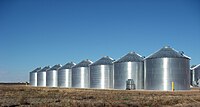
Photo from wikipedia
Five ruminally cannulated heifers were used in an incomplete 6 × 6 Latin square design to determine the effects of cereal silage (barley vs. corn), cereal grain (barley vs. corn… Click to show full abstract
Five ruminally cannulated heifers were used in an incomplete 6 × 6 Latin square design to determine the effects of cereal silage (barley vs. corn), cereal grain (barley vs. corn vs. a 50:50 blend of barley and corn), and their interaction (S×G) on dry matter intake, ruminal fermentation, total-tract digestibility, nitrogen balance, and in situ degradation. Corn silage (CS) or barley silage (BS) were included at 8% of dietary dry matter (DM). Within each silage source, diets contained (DM basis) either dry-rolled barley (BG; 86%), dry-rolled corn (CG; 85%), or an equal blend of barley and corn (BLEND; 85%). Periods were 25-d, with 5 d of dietary transition, 13 d of dietary adaptation, and 7 d of data and sample collection. Samples collected included feed and refusals, total urine and feces, and ruminal fluid. All data were analyzed using the Mixed model of SAS with the fixed effects of silage, grain, and the S×G. Dry matter intake (P ≥ 0.19) and mean ruminal pH (P ≥ 0.096) were not affected by the silage, grain, or S×G. Total short-chain fatty acid concentrations were greater for BLEND than BG or CG (grain, P = 0.003) and for CS (silage, P = 0.009) relative to BS. The molar proportion of acetate was greater for BS-BG and BS-CG (S×G, P < 0.001), while molar proportion of propionate was greater for CS-BG (S×G, P < 0.001) relative to other silage and grain source combinations. Rumen ammonia-N concentration was greater for CG than BG, or BLEND (grain, P < 0.001), and greater for CS compared to BS (silage, P = 0.023). Apparent total-tract digestibility of DM, organic matter, neutral detergent fibre, starch, and gross energy were greatest for BG (grain, P ≤ 0.035). Digestible energy content (Mcal/kg) was greater for BG (grain, P = 0.029) than CG and BLEND. Total nitrogen retention (g/d and % of intake) was greatest for CS-BG (S×G, P ≤ 0.033) relative to all other treatments. In situ degradation rates of DM, crude protein, and starch were greater for BG than CG (P ≤ 0.004). The potentially degradable fraction of DM, crude protein, and starch were greater for CG (P ≤ 0.031), while the undegradable fraction was greater for BG (P ≤ 0.046). For silage sources, CS had greater 24 h in situ DM digestibility (P = 0.009) and starch digestibility (24, 48, and 72 hr incubations, P ≤ 0.034) relative to BS. Results suggest that while feeding a combination of CS and BG promotes propionate production and greater N retention; few other additive effects were observed.
Journal Title: Journal of animal science
Year Published: 2020
Link to full text (if available)
Share on Social Media: Sign Up to like & get
recommendations!